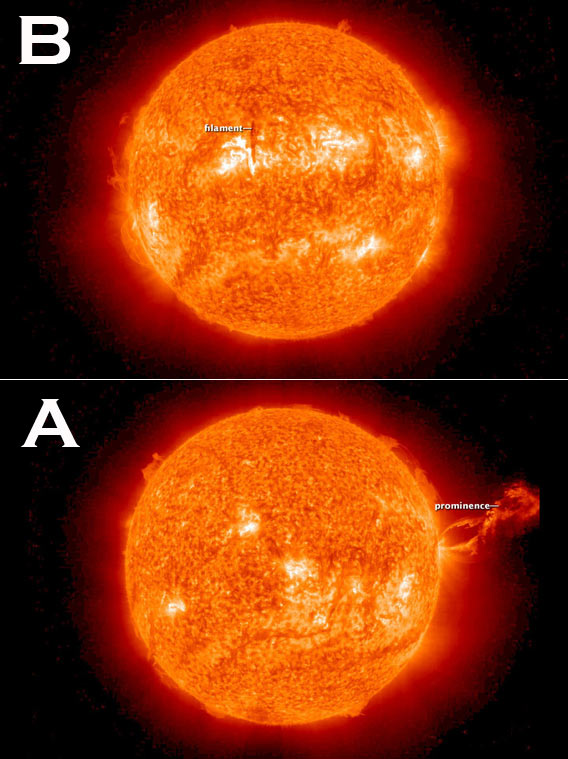Create a free profile to get unlimited access to exclusive videos, sweepstakes, and more!
Angling in on a Massive Solar Eruption

Our Sun is a feisty beast.
Itâs a roiling cauldron of gas, so hot that electrons in the gas have been stripped away, creating whatâs called a plasma. Currents of rising and twisting plasma underneath the Sunâs surface create intense and convoluted magnetic fields, which in turn affect the shape and behavior of the gas. Piercing the surface, these magnetic fields create gigantic loops along which the plasma flows, like beads along the wires of an abacus. Vast energies are stored in these loops, and sometimes they explode. Violently. Very, very violently.
That image shows whatâs called a prominence, one of these towering arcs of plasma. You can see it clearly in the bottom picture, but where is it in the top one?
Oh, itâs there, but you need a little perspective to see it. These two images were taken by NASAâs STEREO (for Solar TErrestrial RElations Observatory) satellites; twin spacecraft that view the Sun from two widely different angles. One was launched in a way that sent it ahead of the Earth in its orbit (called STEREO A for âaheadâ) and the other launched to lag behind (STEREO B, for âbehindâ).
On Oct. 14, 2012, the spacecraft took the two pictures above. Iâve labeled them to show which is the view from which spacecraft. STEREO A saw the loop from the side, arcing high above the Sunâs surfaceâabout 500,000 kilometers (300,000 miles), judging from the picture. Thatâs greater than the distance from the Earth to the Moon!
STEREO B, on the other hand, was almost directly above that eruption, so it sees it edge-on, if you will, looking straight down on it. If you take a moment you can match up some features on the Sun in the two pictures; for example, the white twisted spot to the lower left of the eruption near the Sunâs left edge in the upper image can be seen in the lower one as well.
Note that in the top image it's labeled as a filament, but in the bottom the eruption is labeled as a prominence. Those mean the same thing! Kinda; it depends on your viewpoint. When seen against space, like in the lower image, itâs called a prominence. But when seen against the face of the Sun, like in the upper image, itâs called a filament. Thatâs a holdover from when we didnât really understand the Sun very well; the same feature looks very different depending on how you see it. That should be clear from these two images! So the same event has two names, and we still use both.
No matter what you call it, itâs a spine-chilling event. What youâre seeing here is an eruption that launched billions of tons of gas into space at high speed; an explosion releasing the energy equivalent to at least thousands of times the combined nuclear arsenals of every country on Earth! The Sun doesnât do anything small.
And hopefully, that will give you a little perspective on our nearest star.


























